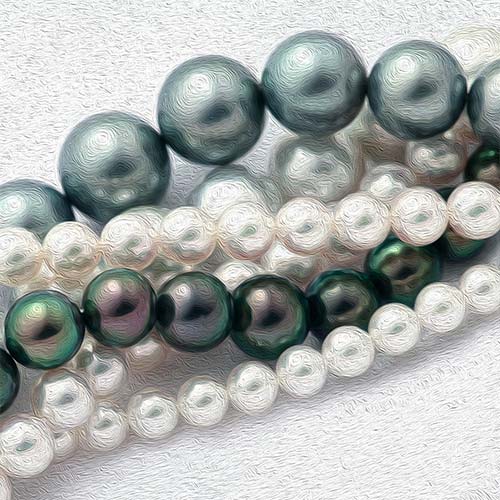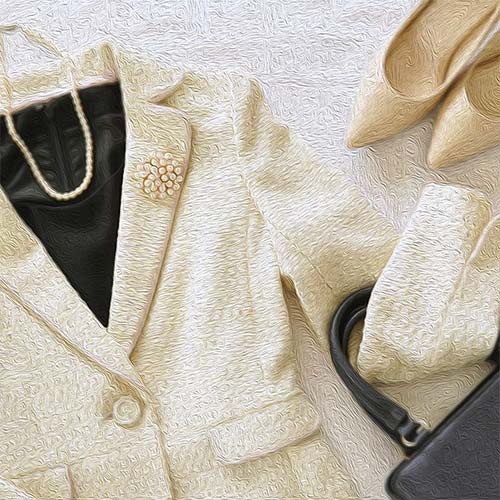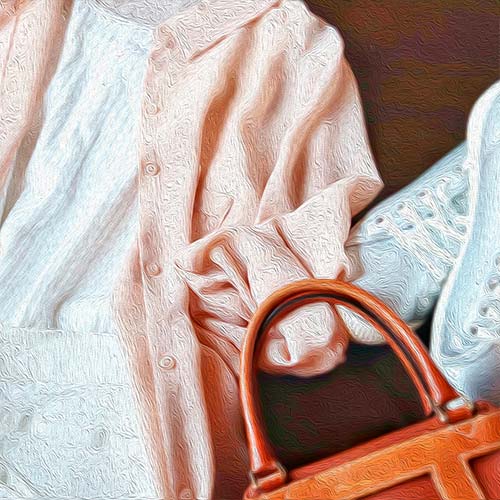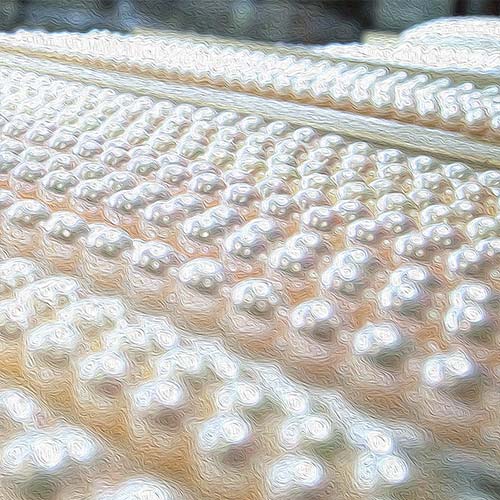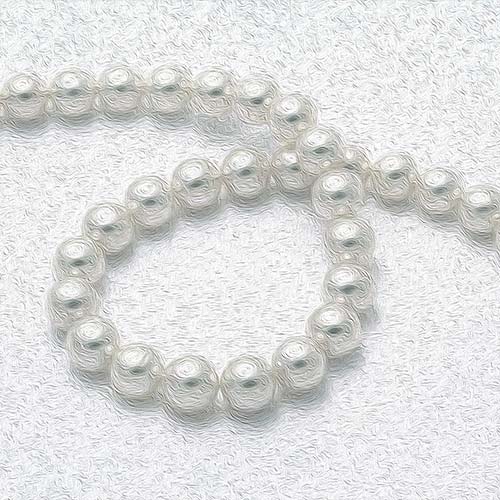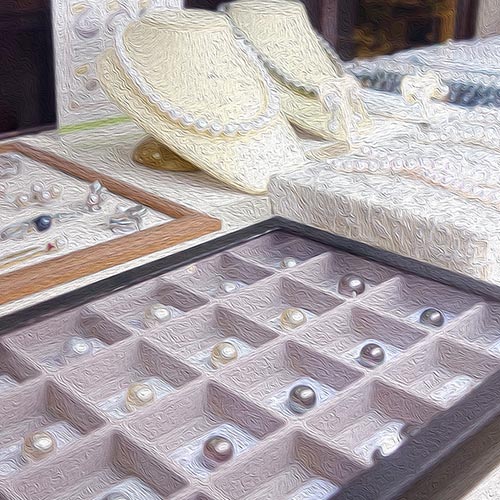●●●
When buying pearls
What criteria should I use to choose?
●●●
When actually purchasing pearls, what criteria should you use and how should you choose them? Here, we will explain the most important criterion for choosing pearls: "pearl quality."
If you haven't yet read the articles about the types and characteristics of pearls, how to wear them in formal situations, and how to coordinate pearls in casual situations, be sure to check these out as well.
PQuality of the product
The difference in quality of pearls is easier to see than that of diamonds, and can be seen with the naked eye. A necklace can cost anywhere from 10,000 yen to several million yen, but when you put them side by side, the difference is obvious!
However, there are some things that are easy to understand at a glance and some that are a little more difficult to understand, so I will explain them step by step. Also, Hojudo's official Instagram account has a special feature on the quality of pearls. I will include a link, so please take a look.Listplease.
on second thoughtsThe easiest thing to see at a glance is the sizeThe larger the pearl, the more luxurious it is, and the higher the price. Akoya pearls, which are the most common in Japan, have a maximum diameter of about 11 mm.For a single pearl strand, the average is 7.0mm to 7.5mmIf the pearl size exceeds 9mm, the price will increase due to its rarity. Small pearls are around 3mm and are called baby pearls and are often used in casual settings. If you are looking for large pearls of 10mm or more,South Sea PearlsIt is recommended to choose one of these. Most are around 11mm to 13mm in size, with the larger ones being around 19mm. Even a 1mm change in size can make a big difference in the feel, so please compare them before making your selection.
▼Official Instagram Pearl Special Feature〈Size〉
If you are looking for a string of pearls and are concerned about the size and length, please read the following article.Please take a look.
▼ Pearl etiquette for formal occasions
2. Teri

The next most obvious difference after size isLusterThis is the difference between the quality of pearls.The most important criterionWithout luster, the pearls would be dull and would give a dark impression to the whole body when worn. It is because of luster that pearls are elegant and refined. The Pearl Science Institute, the highest authority in pearl appraisal in Japan, also places great importance on the luster standard,The strongest class of terriers has a special name called "Aurora.".
The factors that affect this luster and shine are:"Thick roll".
Pearls have a layer of nacre wrapped around the nucleus. The thickness of this layer is called the nacre thickness, and the thicker it is, the deeper the shine will be and the higher the value will be. On the other hand, if the nacre thickness is thin, the luster will be weaker and it will deteriorate faster. However, a thick layer does not necessarily mean beautiful (some pearls are thick but cloudy). The "nacre thickness" is the thickness of the nacre layer. Don't judge it based on the nacre thickness alone, but look at it with your own eyes.
▼Official Instagram Pearl Special Feature〈Shiny Edition〉
▼Official Instagram Pearl Special Feature〈Maki Edition〉
3. Dimples (scars)

At first glance, you won't notice any difference in size or luster, but if you look closely, you'll notice some dents and protrusions.DimplesIf you are particular, you should also check the condition of your dimples.
▼Official Instagram Pearl Special Feature〈Dimples Edition〉
4. Shape

The shapes are roughly divided intoRound (perfect circle),Semi-round (almost perfectly round),Semi-baroque (slightly modified),Baroque (variant)Round ones are more expensive and have a more formal feel, soFor ceremonial occasions, round or semi-round glasses are used.Let's make sure to do so.
If you want a casual look for everyday use, baroque is a stylish option.
▼Official Instagram Pearl Special〈Shapes〉
trueSpecial designation of pearls (Pearl Science Institute)
Among the pearlsThose that are of particularly good quality are given the "Special Designation."There are many names for each type of pearl, and they also vary depending on the appraisal agency. Here are the most well-known and trusted ones.Pearl Science InstituteUsing the name ofAmong them, we would like to recommend some special names.Let me explain.1. Aurora Hanadama (Akoya pearl/white)
Since ancient times, high-quality pearls have been called Hanadama, and it is the most familiar name. Aurora Hanadama is the highest quality white pearl with the strongest luster, but there is variation in quality, so we recommend that you check the actual product.
▼Hojudo's Aurora Hanadama
2. Aurora Tennyo (Akoya pearl/white)
This is also the highest quality white pearl with the strongest luster, but it is a designation given to Hanadama pearls with especially strong luster. It is top class among Akoya pearls, and its beauty is immediately obvious at a glance. Although it is expensive, it is recommended for those looking for the highest quality Akoya pearls to last a lifetime.
▼Aurora celestial maiden at Hojudo
3. Aurora Venus (white South Sea pearl/silver)
Aurora Venus is the finest class of South Sea white pearl. It is larger than Akoya pearls and recommended for those looking for the highest quality.
4. Aurora Brown Gold (White South Sea Pearl/Golden Pearl)
Aurora Brown Gold is the highest quality of golden pearl. In Europe and the US, it is also called "Creamy Pink." The divine brownish gold color has a gorgeous luster that emerges from deep within, but it also gives off a somewhat calming atmosphere.
5. Aurora Lagoon (black pearl/green)
Aurora Lagoon is the highest quality black pearl. Although it is a black pearl, it has a calm green color, but the luster that emerges from deep within the pearl, combined with the black color, enhances the sense of luxury.
6. Aurora Peacock (black pearl/green)
Peacock may be more familiar among black pearls. As the name suggests, peacock is based on green with yellow and red hues, and is characterized by its beauty reminiscent of a peacock's feathers. If you prefer a calm color in black pearls, we recommend Lagoon, and if you are looking for something more glamorous, we recommend Peacock.
ToneAbout color and no color
When researching pearls, you often hear the term "uncolored."Customers often ask, "I hear about colorless products all the time, but what does that mean?"
In a word, "non-toned colors are beautiful even without toning treatment." We often use the expression "toning = makeup." In other words, non-toned colors are beautiful even without makeup, they are beautiful without makeup.
After pearls are taken out of the shells and treated, they are "toned" to bring out the natural beauty of the pearls (they are not colored). Most pearls are toned to give them a uniform color, and then they are tied together in a necklace.
On the other hand, untoned pearls are beautiful enough without any toning treatment, so there is no need to do anything more. Because they are rare, they are more expensive than toned pearls. In terms of appearance, the recent trend is that toned pearls are slightly pink, while untoned pearls are slightly yellowish.
As you can see, toning and non-toning are just a matter of technique, and it doesn't mean that toned pearls are of lower quality. For those looking for rare pearls or those who are uncomfortable with pink, we recommend non-toned pearls, but it's a good idea to actually try them out to see how they match your skin.
At Houjudo, we carry both tinted and non-tinted pearls, so be sure to compare them for yourself.
▼Hojudo pearl necklace
+++
How was it?
We also introduce various other topics about pearls in our special columns.
Please feel free to use this as a reference!
Feature Column



